
The Ups and Downs of Short Haul vs. Rescue Hoist Operations

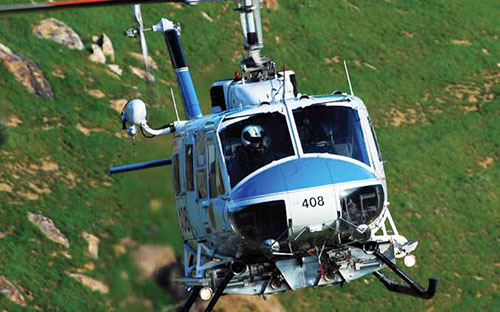
Before I talk about rescue hoist installation and maintenance, I am going to mention some terms and concepts that might not be familiar to some HeliMxreaders. In the 1980s, CAL FIRE became one of several U.S. agencies that adopted “short haul” rescue techniques that had been developed by European and Canadian search and rescue agencies in the 1960s. Our need was to rescue firefighters who were injured or blocked from escape routes during wildland fires. Short haul means moving people suspended from ropes or cable from the rescue location to some place where they can be safely unhooked from the rope or cable. The helicopter can land and the people who were unhooked are moved inside the helicopter to continue the flight. Short haul may also involve rappelling from the helicopter, but rappel implies that the person descending controls their own descent rate and CAL FIRE does not include rappel in our protocols.
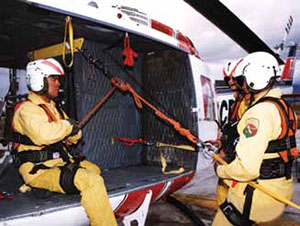 Short haul, as it has been performed by CAL FIRE, requires lowering the rescuer and the rate is controlled by personnel in the helicopter. It is a proven protocol and is used throughout the U.S. with approvals from the U.S. Forest Service (USFS), Department of Agriculture (DOA) and the Department of the Interior (DOI) Office of Aviation Services (OAS).
Short haul, as it has been performed by CAL FIRE, requires lowering the rescuer and the rate is controlled by personnel in the helicopter. It is a proven protocol and is used throughout the U.S. with approvals from the U.S. Forest Service (USFS), Department of Agriculture (DOA) and the Department of the Interior (DOI) Office of Aviation Services (OAS).
There is an excellent guide (the Interagency Emergency Helicopter Extraction Source List) which can be found at wildfirelessons.net/documents/Emergency_Extraction.pdf. It lists those aircraft equipped for short haul or rescue hoists and their U.S. locations. California, because of its size, population and topography, has more government-owned and contracted aircraft set up for these operations than anywhere else in the U.S.
Several years ago, Bill Payne, the senior aviation officer at CAL FIRE Aviation Management, began discussions about moving from short-haul techniques to the use of rescue hoists due to the dangers associated with flying even small distances with people suspended from the helicopter.
Our mission has expanded from its original goal to using these techniques for rescuing any victim for whom a helicopter extraction is deemed (as assessed by appropriate risk management protocols) to be the best way to achieve a positive outcome. Hoists offer less exposure to rescuers and victims and perhaps a faster flight to the destination. CAL FIRE, the USFS and DOI have strict guidelines as to what the training requirements are for their contracts. For a more detailed explanation of how public use agencies operate, I refer you to a previous article I wrote for the December 2009/January 2010 issue of HeliMx. Under FAR 133 Class D, external loads include any suspended load that may not be jettisoned or are not class A, B or C loads. (Think about it!) Private companies can perform Class D external loads pursuant to their FAA-approved 133 certificate and operating specifications. Strange as it sounds, the requirements for FAA approval do not exist for public use agencies.
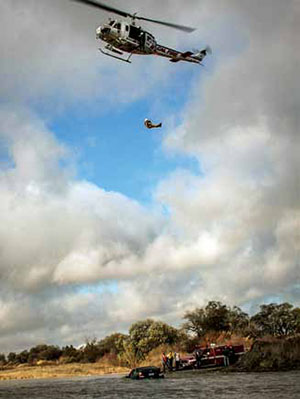 Most of what we see in terms of rescue aircraft is military or owned/operated by public use agencies. In the latter group are the aircraft that are operated under contract to public use agencies but are privately owned. Privately owned (i.e., civilregistered) aircraft can be exempted from the FAR Part 133 (external load) requirements if they are contracted to a federal agency like the USFS or DOI, even if the work period is less than one day. However, for a state or local government contract, the aircraft must be on an exclusive use contract for a minimum of 90 days before it is considered public use.
Most of what we see in terms of rescue aircraft is military or owned/operated by public use agencies. In the latter group are the aircraft that are operated under contract to public use agencies but are privately owned. Privately owned (i.e., civilregistered) aircraft can be exempted from the FAR Part 133 (external load) requirements if they are contracted to a federal agency like the USFS or DOI, even if the work period is less than one day. However, for a state or local government contract, the aircraft must be on an exclusive use contract for a minimum of 90 days before it is considered public use.
These are federal regulations. The aircraft cannot perform other work during the contract period or it falls out of being public use and the requirement for being in compliance with FAA regulations becomes effective. For an aircraft that is not in public use to perform Class D external loads, the company must have a Part 133 operating certificate and the aircraft and crew must meet the requirements under that FAR for Class D loads. The helicopter has to be certificated as Category A (twin engine, among other things) and meet the rest of paragraph 133.45(e). The most common types of civil operations that perform Class D hoist flying that do not have governmental contracts are those that bring harbor ship pilots to the ships that they are required to bring into port, and some EMS companies equipped for SAR missions. Outside of afederalcontract, the only way a privately-owned, single-engine helicopter can do Class D loads is if it is under a contract that requires exclusivity to that contract during a period of at least 90 days to the contracting state or local agency. If such an agreement exists, private operators may perform any kind of external load outside of an existing 133 certificate or without having that certificate at all. If private operators are not contracted for exclusive use for 90 days, they must adhere to the limitations issued on their certificate from the FAA. That is why you see some privately-owned contracted helicopters doing hoist or short-haul missions that are not Category A aircraft, and why public use agencies can use their own single-engine helicopters for hoist or short-haul work. There are also FAA waivers available to allow Class D loads to be flown by single-engine helicopters for motion picture production and certain types of power line or construction operations.
Now that we have discussed the background, I will point out that as reliable as short haul has been for CAL FIRE, we have made the financial and training commitments to install rescue hoists in our helicopters. We are no longer performing short-haul rescues. By the 2013 fire season, all of our helicopters will be equipped with hoists.
The Equipment
Hoists come in two basic styles and there are two U.S. manufacturers of rescue hoists: Breeze Eastern and UTC (United Technologies Corporation) Aerospace, formerly Goodrich. Most hoists are DC electric, but there are hoists that are 115vAC or hydraulically powered. There are two basic types of cable wind systems. The “level wind” system is most common and winds the cable like a fishing reel, in that the cable guide moves back and forth along a stationary drum when reeling the cable in or out. The “translating drum” system moves the drum back and forth. The translating drum allows the cable to be drawn off or reeled on the drum at a single point, rather than moving the cable as it is reeled. In turn, this allows a boom head that has a driven traction sheave that may better distribute cable loads at the cable drum interface.
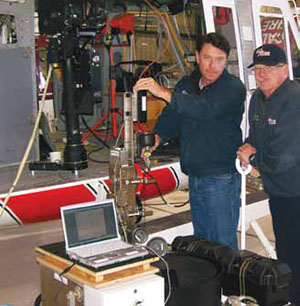 Some rescue hoists are mounted externally to the airframe and other hoists are mounted to internal hard points, so that no part of the system is visible outside the helicopter unless a door is opened. Both styles are used by various militaries and also in type-certificated aircraft. Each type of hoist has advantages and disadvantages. Although they perform the same basic functions, each operator evaluates how they will use the hoist and in what environment they plan to operate to determine which type of hoist best suits their mission requirements.
Some rescue hoists are mounted externally to the airframe and other hoists are mounted to internal hard points, so that no part of the system is visible outside the helicopter unless a door is opened. Both styles are used by various militaries and also in type-certificated aircraft. Each type of hoist has advantages and disadvantages. Although they perform the same basic functions, each operator evaluates how they will use the hoist and in what environment they plan to operate to determine which type of hoist best suits their mission requirements.
The external hoists are also adaptable by STC or OEM installation to a wider variety of airframes than are the internal hoists. Our internal hoists may be moved to any one of four positions in the helicopter (forward LH or RH and rear LH or RH). Some pilots prefer hoisting from one position or the other, or weight and balance considerations may dictate where the hoist is best mounted. With the external hoist, once the kit is installed it is a single position unit due to the fixed supporting parts that are required. The primary users of internal hoists are military and ex-military aircraft. There is only one OEM (UTC Aerospace) that makes an internal hoist. Our hoists would be useable in the UH-1 series, 205, 212, 412 Bells and the UH-60 Blackhawk. CAL FIRE selected internal hoists because when removed, they leave no fixed weight in the aircraft. The external hoists leave substantial weight from both structural modifications required for mounting and electrical components that remain in the aircraft if the hoist itself is removed. Additionally, since the pivot point of the internal hoist is inside the helicopter and the boom is motor driven, moving a suspended load like a litter into the helicopter is easier than it would be with an external hoist.
Weight is critical for CAL FIRE missions but we need to have the hoist near the helicopter for it to be installed on short notice. Our helitender vehicles follow the helicopter and can store the hoist in a cabinet on a rack designed by Bob Innis, one of our fire captains from our Hemet-Ryan Helitack Base in southern California. Our hoists are not usually left in the helicopters during fire season. The reverse is true in winter at most of our bases. A disadvantage for us is that it takes about 15 minutes to configure for a hoist operation. It could be longer if the helitender is not close by. The external hoists all have airframe modifications that require many man hours to install. Installation kits might not be sold by the hoist manufacturer, but rather from aftermarket suppliers such as Aeronautical Accessories. Fixed components may weigh 50 pounds or more.
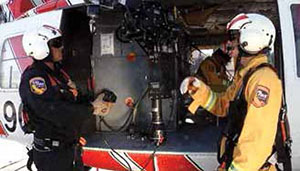 The hoist maintenance manual includes all of the inspections required for continued airworthiness. For our model, inspections include “before first flight,” “daily before each flight,” “after last flight of the day,” “annually,” ”monthly,” and so on. We keep a hoist maintenance log with each hoist. This log follows the hoist if it moves to another airframe or to our maintenance facility. We keep records for each hoist at our main facility, but the daily and monthly maintenance is recorded in the book that stays with the hoist. The Helitack crews have been trained to perform routine maintenance, including cable and hook changes and servicing. Our hoists have three electric motors (a cooling fan, the winch drive motor and the boom motor which rotates the hoist) and two gearbox reservoirs that are lubricated with Dextron fluid.
The hoist maintenance manual includes all of the inspections required for continued airworthiness. For our model, inspections include “before first flight,” “daily before each flight,” “after last flight of the day,” “annually,” ”monthly,” and so on. We keep a hoist maintenance log with each hoist. This log follows the hoist if it moves to another airframe or to our maintenance facility. We keep records for each hoist at our main facility, but the daily and monthly maintenance is recorded in the book that stays with the hoist. The Helitack crews have been trained to perform routine maintenance, including cable and hook changes and servicing. Our hoists have three electric motors (a cooling fan, the winch drive motor and the boom motor which rotates the hoist) and two gearbox reservoirs that are lubricated with Dextron fluid.
There are life-limited items on our hoists. These are the cable and the explosive “squib” (cable-cutting device) used for emergency jettisoning. The cable is good for 1,500 cycles or 55 hours. For our hoist, a cycle is defined as any time 16 feet or more of cable is let out and retracted, regardless of weight on the hook. There is an hour meter for recording hoist operational time. Other hoists have cycle counters that may involve using a formula to compute cycles, but we must keep track manually. The squibs are good for five years from date of manufacture. The hoist we use also has a 10-year overhaul interval. The OEM provides routine maintenance training including all normal servicing, inspection, adjusting and replacing the cable and squib assemblies. They do not include what is considered depot-level maintenance (overhaul) in the military. At present, UTC Aerospace does not offer an overhaul course. Broken hoists generally need to go back to the OEM.
The cables absorb most of the routine maintenance time for hoist operators. As with short haul ropes, they are sensitive to abuse. Despite being rugged for handling what they are used for, they can be easily damaged if mishandled. There are washing/lubricating procedures for when the cable gets dirty — dirt is a real enemy of both the cable and the hoist drum mechanism. The U.S. Coast Guard needs to perform these procedures more frequently as the salt water environment they operate in and around is hard on this equipment.
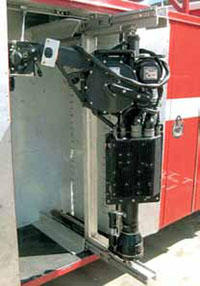 The cable is special, and as far as I know is not manufactured for any other purpose. Cables are available from the hoist OEMs. There are only two domestic manufacturers of this type of cable. They are not standard aircraft cable. Cables consist of 12 strands (a strand is seven wires) wrapped around a center core of six strands of seven wires, wrapped around a center strand of seven wires. If you are keeping track, that is 133 wires. Both U.S.-based OEMs use the same type of cable. The inner core wires are wrapped in a left-hand lay, and the outer wires in a right-hand lay. This tends to keep the wire from twisting. It has a breaking tensile strength of 3,300 pounds, and our hoist is rated at 600 pounds on the hook. The cable diameter is roughly 3/16 inch. One of the cable checks is to use a micrometer and measure the cable (twice at 90 degrees) every 25 feet to detect flattening, necking or abrasion.
The cable is special, and as far as I know is not manufactured for any other purpose. Cables are available from the hoist OEMs. There are only two domestic manufacturers of this type of cable. They are not standard aircraft cable. Cables consist of 12 strands (a strand is seven wires) wrapped around a center core of six strands of seven wires, wrapped around a center strand of seven wires. If you are keeping track, that is 133 wires. Both U.S.-based OEMs use the same type of cable. The inner core wires are wrapped in a left-hand lay, and the outer wires in a right-hand lay. This tends to keep the wire from twisting. It has a breaking tensile strength of 3,300 pounds, and our hoist is rated at 600 pounds on the hook. The cable diameter is roughly 3/16 inch. One of the cable checks is to use a micrometer and measure the cable (twice at 90 degrees) every 25 feet to detect flattening, necking or abrasion.
Another defect is “bird caging,” a permanent loose condition of the outer strands. Bird caging, if very minor, can be barely visible and may not be permanent. “Seasoning” or “conditioning” the cable might eliminate minor bird caging. This refers to the procedure used when putting a new cable in service, but can also be done to a used cable where you hover the helicopter, reel out all of the cable, and then attach (in our case) a 500-pound weight and reel it all the way up. This ensures that the outer part of the cable is properly seated against the inner part. The two parts of the cable experience some small amount of normal shifting during use if the full length is not used under load.
Zephyr International specializes in hoist cable inspection and maintenance. It manufactures a cable inspection and maintenance device that can, by magnetic non-destructive testing, inspect the full length of a cable and provide a graphic trace on a laptop computer to show anomalies. These defects may not be measurable by visual or dimensional checks, such as internal broken strands or very slight defects. It also makes it possible to inspect every inch of the cable as opposed to checking for dimensional issues at suggested intervals in the maintenance manual. It is not a substitute for a tactile and visual inspection of the cable at the times listed in the maintenance manual. We perform this when a cable is new to obtain a baseline, and on an annual basis thereafter unless an issue is suspected. In that instance, the cable is sent to our shop and we run it through the “Mag-Sense” machine.
The Zephyr model ZGS-10000-5 machine can be used to perform routine cleaning and lubrication of the cable, and can also be used to season a cable during installation. If a Helitack crew removes a cable due to finding a defect, they tag it with the hoist hours and cable cycles, and since the pendant (hand control box) has a cable length readout, they can tell where on the cable they found a defect. Broken wires are cause for rejection but are not as common as bird cages or abrasions. As with all cable inspections, gloves or a rag on your hand are advisable until you know the cable is smooth. Each base keeps a spare cable and a small inventory of parts that will keep them in service through minor maintenance. They have a hoist tool box with a few special tools and all of the hand tools needed to keep the hoist operational. Changing a cable may be done anywhere, but it is best performed with a clean cylindrical container that can be rotated as the cable comes off the hoist to avoid kinking the cable. A kink is formed when a permanent bend is made in the cable and is cause for rejection. Certain abrasions (wear into a wire) are permissible if they meet the limits in the maintenance manual.
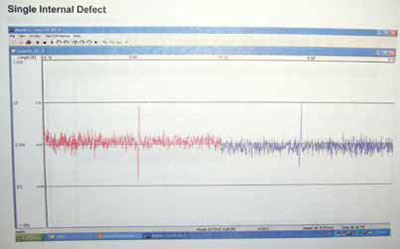 The cable-cutting squib circuit is designed so either the pilot or hoist operator can sever a cable in an emergency. If there is a useful length on the drum remaining, a cable that has been severed can be kept in service by attaching a device that is designed to attach a new hook to the severed end in less than one minute. This would only be in an emergency situation, and if this device is used there would be no squib cutter available. If the cable should have to be cut again (a really, really bad day), only the hand cable cutter that the crew carries could be used. With the hoist that we use if a cable is cut, the cable, squib AND the cutting parts must be replaced.
The cable-cutting squib circuit is designed so either the pilot or hoist operator can sever a cable in an emergency. If there is a useful length on the drum remaining, a cable that has been severed can be kept in service by attaching a device that is designed to attach a new hook to the severed end in less than one minute. This would only be in an emergency situation, and if this device is used there would be no squib cutter available. If the cable should have to be cut again (a really, really bad day), only the hand cable cutter that the crew carries could be used. With the hoist that we use if a cable is cut, the cable, squib AND the cutting parts must be replaced.
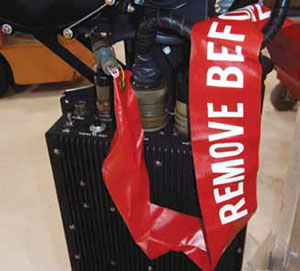
It is recommended that a hand cutter either be of special design for SAR applications or at least not a single-handed cutter. The explosive squib and the cutter with the associated anvil must be replaced along with the cable to restore normal airworthiness after it has been fired. A cable may cost $2,500-$3,000 and the squib and cutting parts increase the cost of such an event substantially. Obviously, that is never a consideration if the cable needs to be severed. When the hoist is being worked on or stored out of the helicopter, the squib should either be removed and electrically shorted, or at minimum shorted out so the chance for unintentional firing is minimized. We have designed a “dummy” plug with a couple of jumper wires that allows us to do this without disconnecting the safety-wired squib connector. It has a large red flag attached so it will always be removed when the hoist is in the helicopter. The photo also shows the work stands we designed to store or work on the hoists. With our installation, it is easier to perform some maintenance when the unit is in the helicopter, but there are some things that are more convenient to do while on the work stand.
Our hoist weighs about 170 pounds and is obviously top heavy. It is possible for two people to install or remove it, but a crew of three is advised. There are three quick disconnects: one on top, one on the bottom and one on the “reaction arm” which is the mount that allows the boom to be motored and fixed in position. One cannon plug provides power and squib firing for the pilot. Our Helitack crews are all trained for installation and removal of the hoist.
The rescue hoist is yet another piece of utility helicopter optional equipment that allows our mission to expand from fires and floods, to injured citizens in the wilderness, and any other emergency or disaster situations where landing an aircraft is not possible to move people who are injured or in harm’s way.
 Jon Robbins has been an A&P mechanic for 32 years. He holds IA and private pilot & instrument airplane ratings. He supervises the helicopter maintenance program at CAL FIRE. Robbins is also on the HeliMx magazine advisory board. His email is jon.robbins@fire.ca.gov
Jon Robbins has been an A&P mechanic for 32 years. He holds IA and private pilot & instrument airplane ratings. He supervises the helicopter maintenance program at CAL FIRE. Robbins is also on the HeliMx magazine advisory board. His email is jon.robbins@fire.ca.gov
